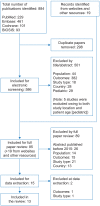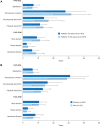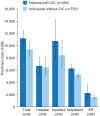The Humanistic and Economic Burden of Chronic Idiopathic Constipation in the USA: A Systematic Literature Review
- PMID: 32765039
- PMCID: PMC7371558
- DOI: 10.2147/CEG.S239205
The Humanistic and Economic Burden of Chronic Idiopathic Constipation in the USA: A Systematic Literature Review
Abstract
Background: Chronic idiopathic constipation (CIC) is a functional gastrointestinal disorder with an estimated prevalence of 16% in the USA; however, the humanistic and economic burden of CIC is poorly characterized.
Aim: This systematic literature review aimed to assess the humanistic and economic burden of CIC in adults in the USA.
Methods: Two systematic literature searches of English-language publications on the humanistic and economic burden of CIC in adults in the USA were conducted using electronic databases and other resources. Both searches included the terms "chronic idiopathic constipation" and "functional constipation". Specific terms used in the search on humanistic burden included "quality of life", "SF-36", "SF-12", and "PAC-QOL"; search terms for economic burden included "cost", "resource use", "absenteeism", and "productivity".
Results: Overall, 16 relevant articles were identified. Health-related quality of life (HRQoL) appeared to be reduced in patients with CIC compared with controls and the general US population. Abdominal (r=0.33-0.49), stool (r=0.23-0.33), and rectal symptoms (r=0.53) appeared to be associated with reduced HRQoL. Younger age and female sex were associated with reduced overall HRQoL and greater symptom severity. Direct outpatient costs were higher in patients with CIC than those without CIC (US$6284 vs US$5254). Patients with CIC and abdominal symptoms reported more days of disrupted productivity per month than those without abdominal symptoms (3.2 days vs 1.2 days). The overall prevalence of complementary and alternative medicine use by patients with CIC was similar to that in the general US population.
Conclusion: The reduced HRQoL and increased costs associated with CIC indicate unmet therapeutic need in this disorder. Further research is required to better understand the humanistic and economic burden of CIC in the USA.
Keywords: chronic idiopathic constipation; economic burden; functional constipation; health-related quality of life.
© 2020 Nag et al.
Conflict of interest statement
AN is an employee of Shire, a member of the Takeda group of companies and has received stock from Takeda. SM is an employee of RTI Health Solutions, Ann Arbor, MI, USA. OO-A, DM, and MP are employees of RTI Health Solutions, Durham, NC, USA. RMV is an employee of RTI Health Solutions, Manchester, UK. RTI Health solutions received financial support from Shire Development LLC, a member of the Takeda group of companies for participation in the study design, data analysis, and data interpretation. The authors report no other conflicts of interest in this work.
Figures





References
Publication types
LinkOut - more resources
Full Text Sources
Medical
Miscellaneous

